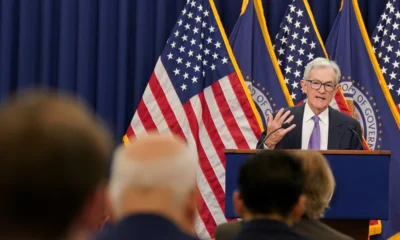U.S. News
Measles Outbreak Surges Past 25-Year Record as Trump’s CDC Pick Faces Razor-Thin Senate Vote The Decision to Vaccinate Is a Personal One Says HHS
With 1,288 U.S. measles cases already in 2025, CDC leadership hangs in balance as Senate inches forward on Trump’s nominee, amid rising vaccine skepticism.

The United States has just crossed a dangerous new milestone: more confirmed measles cases in 2025 than in any year since the virus was declared eliminated in 2000. The Centers for Disease Control and Prevention (CDC) confirmed 1,288 cases so far—surpassing the previous record of 1,274 in 2019—even as the agency awaits permanent leadership under President Donald Trump’s second term.
This public health alarm coincides with the controversial Senate committee vote on the president’s nominee to lead the CDC, Dr. Susan Monarez, a seasoned immunologist and federal scientist. The Senate Health, Education, Labor and Pensions Committee voted 12–11 to advance Monarez’s nomination, signaling deep political division as vaccine confidence continues to falter nationwide.
We’re witnessing the consequences of mixed messaging,” said one public health expert. “When people stop trusting vaccines, preventable diseases like measles make a comeback.
According to Johns Hopkins University’s Center for Outbreak Response Innovation, which tracks outbreak data in real time, this year’s surge is well ahead of the CDC’s own update cycle. Typically, measles cases average around 180 annually since elimination was declared—making the 2025 surge a major red flag.
HHS Under Scrutiny as Vaccine Messaging Shifts
Meanwhile, the Department of Health and Human Services, now under the leadership of Robert F. Kennedy Jr., issued a statement that stopped short of addressing the outbreak’s gravity. The agency reiterated its support for local response efforts but described vaccination as a “personal decision,” echoing Kennedy’s longstanding views on vaccine policy.
CDC continues to recommend MMR vaccines as the best way to protect against measles,” the HHS statement read.
“The decision to vaccinate is a personal one. People should consult with their healthcare provider to understand their options.
Critics say this language represents a softening of federal guidance that once promoted widespread vaccination as essential to public health.
Kennedy has previously come under fire for his controversial views on childhood vaccines, and he recently replaced the CDC’s Advisory Committee on Immunization Practices (ACIP) with a reduced panel of seven members—several of whom have questioned vaccine safety.
“This administration is chipping away at decades of trust in immunization,” warned a spokesperson from the American Academy of Pediatrics.
Senate Divided Over CDC Leadershi
Dr. Monarez, who spoke during her confirmation hearing about restoring public trust in science, defended Kennedy’s decision to restructure ACIP, stating it was necessary to “diversify perspectives.”
Despite her scientific credentials, Monarez’s nomination has been caught in the partisan crossfire over vaccines. All Republican members of the committee supported her, while Democrats opposed, citing concerns about her alignment with the administration’s vaccine messaging.
If we want to control outbreaks like this, we need a CDC director who will speak clearly and confidently about vaccines—not hedge,” one committee Democrat said.
Monarez will now face a full Senate vote, where her confirmation remains uncertain. Meanwhile, the CDC, amid the worst measles outbreak in a generation, continues to operate without a permanent leader.
The Bigger Picture: Vaccine Confidence in Crisis
Back in 2019, when measles cases last surged, the CDC and HHS Secretary Alex Azar quickly issued strong public statements encouraging Americans to vaccinate.
Now, nearly six months into Trump’s second term, the tone from Washington is more ambiguous—and the stakes have never been higher.
This isn’t just about measles,” said an epidemiologist with the Johns Hopkins Bloomberg School of Public Health. “It’s about whether Americans still believe in science, in public health, and in the institutions meant to protect them.
U.S. News
Thanksgiving Chaos or Convenience? Here’s What’s Actually Open Today — And What Isn’t…
From grocery runs to fast-food cravings and Black Friday madness — your complete Thanksgiving 2025 guide to what stays open, what shuts down, and where Americans can still grab a last-minute lifeline.

Thanksgiving morning in the United States often begins with the aroma of roasting turkey — and sudden panic when someone realizes they’re missing cranberries, stuffing mix, or that one essential ingredient grandparents swear by. But before Americans get in the car to hunt down an open store, 2025’s holiday schedules may surprise them.
A number of major retailers, including giants like Target and Costco, have opted to keep their doors firmly shut this Thanksgiving, continuing a trend that began during the pandemic years. Others, however, are offering limited hours — just enough for those last-minute grocery emergencies.
Here’s the complete breakdown of what’s open, what’s closed, and what Americans can expect before Black Friday officially kicks off tomorrow.
Major Retailers Staying Closed Today
If you’re planning a big-box last-minute run, these stores won’t be an option:
- Target – Fully closed nationwide
- Costco – Entire chain closed
- Home Depot – Closed
- IKEA – Closed
- TJ Maxx, Marshalls, HomeGoods, Sierra, Homesense – All closed
- Petco – Closed
- Hy-Vee – Closed
- Aldi and Trader Joe’s – Closed
The nationwide shutdown of these brands reflects a growing cultural shift: Americans want employees to spend Thanksgiving with their families — a sentiment echoed across social media.
Grocery Stores Open — But With Short Hours
Some grocery chains are throwing consumers a lifeline — but only for a few hours:
- Food Lion – Most stores open until 3 p.m. (some Virginia stores until 4 p.m.)
- H-E-B – 6 a.m. to noon
- Kroger – Open until 12 p.m.
- Wegmans – Open until 4 p.m., reopening at 6 a.m. Friday
- Whole Foods – Most stores 7 a.m. to 1 p.m., except those in Massachusetts, Maine, Rhode Island (closed)
- Stop & Shop – CT, NY, NJ locations open until 3 p.m. (MA & RI stores closed)
Anyone needing a last-minute pumpkin pie? Better set an alarm.
Pharmacies & Retail Chains: Mixed Status
Some essential services remain partially available:
- CVS – Open, but with reduced hours depending on location
- Dollar General – Mostly regular hours
- Walgreens – Most stores closed; 24-hour branches remain open for emergencies
If you need medication, calling ahead could save you a disappointing trip.

Fast-Food & Restaurants: Hungry? Here’s Where You CAN Go
For those skipping the cooking — or grabbing a quick breakfast while the turkey thaws:
Open
- Burger King
- Dunkin’ – Many open
- KFC – Varies by location
- Starbucks – Some stores open, hours vary
Closed
- Chick-fil-A
- Most Subway stores
Pro tip: Starbucks’ holiday drinks may be available — if your nearest store didn’t adjust its hours.
Stock Market & Deliveries: No Movement Today
The U.S. financial system takes a breather:
- NYSE & Nasdaq – Closed
- Black Friday schedule: close early at 1 p.m. EST
Mail & parcel services also take a break:
- USPS – Closed (only Priority Mail Express delivered)
- UPS – Closed
- FedEx – Closed (except FedEx Custom Critical)
Black Friday: Which Stores Are Opening Early Tomorrow?
With holiday shopping season officially beginning Friday, many retailers are gearing up to open their doors before sunrise:
- JC Penney – 5 a.m.
- Kohl’s – 5 a.m.
- Best Buy – 6 a.m.
- Macy’s – 6 a.m.
- Target – 6 a.m.
- Walmart – 6 a.m.
- Michaels – 7 a.m.
- TJ Maxx/Marshalls/HomeGoods – 7 a.m. to 10 p.m.
Retail experts predict some of the heaviest Black Friday foot traffic in recent years, especially as inflation has pushed consumers to hunt aggressively for deals.
A Thanksgiving of Changing Traditions
Once upon a time, Thanksgiving meant crowded malls and early-bird deals. Today, the shift toward family time — and away from Thanksgiving Day shopping — has become more pronounced.
Still, whether Americans choose family, football, feasting, or deal-hunting, knowing what’s open today might save them a lot of frustration… and maybe even their holiday dinner.
For more Update DAILY GLOBAL DIARY
U.S. News
Panic at Joint Base Andrews after ‘suspicious package’ triggers evacuation… here’s what really happened inside the Air Force One base
Authorities at Joint Base Andrews, home to Air Force One and some of America’s most sensitive military operations, ordered an evacuation after a mysterious package was delivered on November 6.

A tense few hours unfolded on Wednesday at Joint Base Andrews — one of the most secure military facilities in the United States — after officials reported receiving a “suspicious package”, prompting an immediate evacuation and large-scale emergency response.
The base, located in Prince George’s County, Maryland, just southeast of Washington, D.C., is famously home to Air Force One — the presidential aircraft used by the President of the United States — and serves as a vital hub for national defense operations.
According to a base spokesperson quoted by USA TODAY, the incident began when an individual inside one of the base’s administrative buildings opened a package that appeared suspicious. Within minutes, security protocols kicked in.
“A building and a connecting building were evacuated as a precaution,” the spokesperson confirmed. “A cordon was established around the area, and first responders were dispatched to the scene.”
Emergency sirens rang out across parts of the base as specialized units, including explosive ordnance disposal teams and fire services, arrived to assess the situation.
ALSO READ : Taylor Swift and Gigi Hadid’s Coordinated NYC Dinner Looks Are Giving Major Fall Fashion Inspiration
No Immediate Threat Found, But Investigation Ongoing
By late afternoon, base officials reported that first responders had “determined there were no immediate threats,” allowing personnel to return to their duties. However, an official investigation into the source and nature of the package is now underway.
“Joint Base Andrews first responders were dispatched to the scene, determined there were no immediate threats, and normal operations have resumed,” the spokesperson said. “An investigation is currently ongoing.”
Authorities have not released details about the sender or contents of the package, citing security concerns. Officials have also not clarified whether the Federal Bureau of Investigation (FBI) or the U.S. Secret Service — both of which have jurisdiction over potential threats to presidential assets — are directly involved.
Why Joint Base Andrews Is So Sensitive
Joint Base Andrews, operated by the United States Air Force, is home to the 316th Wing and houses the aircraft that transport top U.S. leaders, including the President, Vice President, and senior defense officials.
It also plays a critical role during national emergencies, serving as a coordination point for NORAD operations and air defense missions over the capital region.

Because of this, even a minor security incident can trigger widespread concern. The base’s proximity to Washington, D.C., makes it a frequent target for heightened alert protocols.
A History of High-Alert Incidents
This is not the first time Joint Base Andrews has faced a security scare.
In 2021, an intruder gained unauthorized access to a C-40 aircraft parked on the base, prompting the U.S. Air Force to overhaul some of its security procedures. In another 2023 incident, the base briefly went into lockdown after reports of gunfire — which later turned out to be a false alarm.
Given this background, Thursday’s response to the suspicious package was swift and comprehensive, reflecting just how seriously base officials treat even the slightest anomaly.
“When it comes to protecting personnel and national assets, there’s no such thing as overreacting,” said a retired Air Force security officer in a phone interview with CNN.
Inside the Rapid Response
Sources familiar with the incident told local media that hazardous materials (HAZMAT) teams and bomb technicians conducted a controlled assessment before declaring the area safe.
All affected buildings were cleared within hours, and no injuries or illnesses were reported among staff or first responders. Operations involving Air Force One were not disrupted, according to officials.
Military analysts say the quick restoration of normal activity underscores the efficiency of Andrews’ Emergency Management and Security Forces teams, who regularly train for such contingencies.
Public Reaction and Online Buzz
As news of the evacuation broke, social media platforms lit up with speculation. Several users on X (formerly Twitter) shared photos of fire trucks and police vehicles lining the base perimeter, while others questioned whether the package might have been linked to recent protests or hoaxes targeting government institutions.
Base officials quickly moved to calm the speculation, emphasizing that “no credible threat” had been found.
Still, the event served as a reminder of how even a single suspicious object can disrupt life at a military installation that hosts some of the most important aircraft and personnel in the world.
A Routine Day Turns Into a Security Lesson
By Thursday evening, operations had fully resumed at Joint Base Andrews, but questions remain: Who sent the package? What was inside? And could it have bypassed initial screening procedures?
The investigation continues, but officials remain confident in the base’s safety protocols.
“Our teams acted exactly as they were trained to do,” one Air Force spokesperson said. “Safety and readiness will always come first.”
For now, the “suspicious package” appears to be a false alarm — but one that served as a crucial stress test for one of America’s most high-stakes military environments.
U.S. News
Dick Cheney’s Cause of Death: A Look at the Former Vice President’s Long Struggle with Health Issues
Dick Cheney, former U.S. Vice President, passed away at 84 after battling pneumonia and multiple heart conditions, including a heart transplant in 2012.

Dick Cheney, the 46th Vice President of the United States, passed away on Monday night at the age of 84. His family confirmed his death in a statement on Tuesday, revealing that Cheney died due to complications from pneumonia and cardiac and vascular disease. Cheney’s health had been a concern for decades, with multiple heart attacks and a heart transplant marking significant milestones in his medical history.
A Legacy of Service Despite Health Struggles
Dick Cheney had an extensive political career, serving in roles such as White House Chief of Staff, Wyoming Congressman, Secretary of Defense, and most notably, Vice President under George W. Bush from 2001 to 2009. He was a key figure in shaping U.S. policy during the post-9/11 era, especially regarding national security and military decisions. However, Cheney’s life was also deeply marked by his health challenges, which he bravely endured alongside his public service.

Cheney’s Health History: From Heart Attacks to a Heart Transplant
Cheney’s first heart attack came in 1978, at the age of 37, while he was campaigning for Congress in Wyoming. This was the beginning of a long and challenging battle with heart disease. His second heart attack occurred in 1988 during his tenure as a Wyoming congressman, which required an angioplasty to treat.
As Cheney rose to national prominence, his health continued to be a concern. In 2000, just before the presidential election, Cheney suffered his third heart attack, yet he was still selected as George W. Bush’s running mate. After taking office as Vice President in 2001, Cheney had a cardioverter-defibrillator implanted to regulate his irregular heartbeat and prevent sudden cardiac arrest.
Multiple Heart Attacks and Heart Transplant
Cheney’s health deteriorated further in the 2000s, suffering his fourth and fifth heart attacks between 2007 and 2010. The fifth heart attack in 2010 left him with severe congestive heart failure, forcing him to use a wheelchair temporarily. His condition required a left ventricular assist device (LVAD) to be implanted in July 2010 to help support his failing heart.
After being on the transplant list for 20 months, Cheney finally received a heart transplant in 2012 at the age of 71. The procedure, which lasted seven hours, marked a new chapter in his battle with heart disease, allowing him to live several more years despite his health challenges.

Living with Health Challenges and Co-Authoring a Memoir
Even after the heart transplant, Cheney continued to manage health issues related to atrial fibrillation and vascular complications throughout the 2010s. He maintained a strict regimen of medication and regular monitoring to manage his condition.
In 2013, Cheney co-authored a memoir titled “Heart: An American Medical Odyssey” with his **co-author, Dr. Jonathan Reiner. The memoir detailed his journey through heart disease, including the medical procedures he underwent and his experience with life-saving medical technologies. Cheney’s ability to continue his public life and political commentary despite his health struggles was seen as a testament to his resilience and determination.
Cheney’s Final Years and Legacy
As a former Vice President and Secretary of Defense, Cheney’s impact on American politics is profound. However, his long history with heart disease was equally significant, with medical advances such as the heart transplant and LVAD providing him with years of additional life. Cheney remained active in politics and public life even after leaving office, and his views, particularly on national security, continued to influence policy debates.
He is survived by his wife, Lynne Cheney, their two daughters, and grandchildren. Cheney’s passing marks the end of a long chapter in American politics, and his legacy as both a public servant and a figure who battled significant health challenges will not soon be forgotten.
-

 US News1 week ago
US News1 week ago“She Never Made It Out…” Albany House Fire Claims Woman’s Life as Family Pleads for Help to Bring Her Home
-

 Entertainment7 days ago
Entertainment7 days agoXG Star Cocona Shares a Brave Truth at 20 — “I Was Born Female, But That Label Never Represented Who I Truly Am…”
-

 Entertainment7 days ago
Entertainment7 days agoSamba Schutte Reveals the Surprise Cameo in Pluribus That “Nobody Saw Coming”… and Why John Cena Was Perfect for the Role
-

 Tech1 week ago
Tech1 week agoAfter Losing Over $70 Billion, Mark Zuckerberg Finally Admits His Biggest Bet Is “Not Working” – Meta Plans Massive Cuts to Metaverse Budget
-

 Entertainment1 week ago
Entertainment1 week agoNika & Madison stuns global audiences as director Eva Thomas reveals why “resilience, not fear, drives Indigenous women on the run”
-

 World Economy1 week ago
World Economy1 week ago“A Rare Split Inside the Fed… Why Top Officials Are Bracing for a Rate Cut Even as Inflation Clouds Loom”
-

 Entertainment5 days ago
Entertainment5 days agoSaudi Arabia’s entertainment revolution… Red Sea Film Foundation CEO Faisal Baltyuor says he ‘wears many hats’ — but one mission drives them all
-

 Sports6 days ago
Sports6 days agoDodgers Stun MLB With Blockbuster Move, Sign Elite Closer Edwin Díaz to Three-Year, $69 Million Deal



























